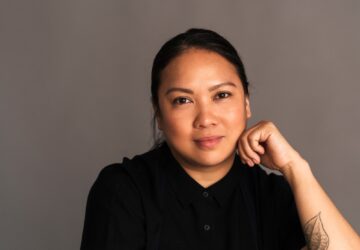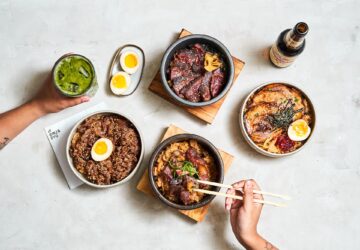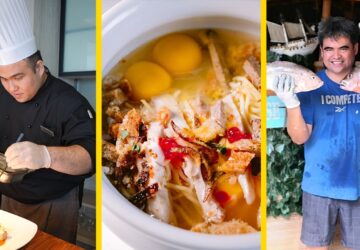


They have this certain energy and drive to elevate the status of Filipino food and elicit a stronger appreciation and better understanding of the cuisine through the dishes they serve. From the name hapag itself, which translates to table, to their 24-seat establishment, you already get a sense that this restaurant is onto something exciting.
The use of simple elements like wood and cement helps them achieve a warm, playful feel. Couple that with their open kitchen where you can hear and see the magic going on, and it’s like you’re transported back to your childhood home, waiting for your mom to finish cooking the next meal of the day.

But they wanted to go beyond just the typical dishes and homecooked meals that Filipinos are all too familiar with. “We wanted to present Filipino food in a different, more elegant way,” he adds. Not that our own dishes are ‘ugly’ per se, but that it can also be presented creatively while staying true to its unique taste and flavor profiles. They have authority, after all, as Filipinos. “No one’s going to come up to you and say that you’re doing it wrong,” according to Dolatre.
And this is what they’ve been doing so far in their restaurant, serving versions of classic recipes that’s going to appeal to the market. However, the experiments and tweaks they do in their kitchens are not just for the sake of shock value or novelty. Despite striving to keep going out of the box and offering something new, they take special care not to bastardize the original recipes.

This reverence for Filipino food can be seen in the menu items that have gained popularity since they opened the business. One of these is a dish inspired by the bonete, which is a buttery pastry similar to a brioche or ensaymada that Villarica’s parents would send to him as pasalubong. They came up with a dish called oyster bonete, turning the pastry into a slider, with fresh oysters, adobo aioli and crispy kangkong inside. It became a hit with the customers, which for them, was a pleasant surprise.
The laing stones are what they would consider a staple of the Hapag menu and their personal favorite of the classic Bicolano dish. Usually served on a plate with some rice, it’s not aesthetically pleasing, but the flavors are delicious. They played around with it and came up with the dish, where guests are invited to interact with their food and introduce the idea of eating straight from the ground. It’s this dish that’s become the face of Hapag, and they’re glad that people are responding positively to it.

says Kevin Navoa
As an outsider looking in, you can tell there’s a lot of love shared between the three chefs—which shouldn’t be surprising since they have known each other since they were still kids. It may have been difficult at the start and there is always that risk of ruining friendships when going into a business together. But they’ve managed to work their way through each other’s personalities and quirks.
They work like a well-oiled machine and now, couldn’t imagine running Hapag without each other. “The food wouldn’t be as good if we don’t get along,” Navoa says.
This love shared among themselves then trickles down to their kitchen and restaurant staff. The chef-owners make sure that their crew is treated right, as if they’re part of a family. For instance, they see to it that everybody eats delicious meals every day, so much so that it’s an integral part of their daily budget. This has evolved into a friendly competition on who gets to make the best staff meal, which, Dolatre shares, they document and showcase on Instagram. One of the most recent dishes they ate was an upgraded version of instant Ichiran ramen that their marketing manager brought home from Japan.
It’s through this initiative that, according to Navoa, “The staff is pushed to cook better, too. Everyone wins at the end of the day.” He adds that they only get to eat once before the service, so they better consume something that’s tasty and filling.

Everyone has a voice in the establishment and the owners ensure that they always listen to their staff. The whole team has the opportunity to contribute and collaboration is highly encouraged, particularly when ideas are needed for new recipes or dishes.
Creating and maintaining the Hapag culture is a top priority as it also contributes to the overall relaxed atmosphere that they want diners to experience. Villarica echoes this statement, saying that “If the people in the kitchen are happy, the owners are happy. Then everyone is happy.”
And this joy translates not just to the food, but to the type of service they provide to customers. “If you care for your staff,” says Navoa, “they will, in effect, care for the guests too.” Dolatre reveals that it’s important for them to build a relationship with their clientele as well. It’s also a great opportunity to introduce the people behind the food. “No matter how busy the kitchen gets, we always make sure to go out and talk to the guests.” They make sure the guests get the experience that they paid for, since they could have easily eaten elsewhere.
They’re at the point now where they can push the boundaries further and step away from their comfort zone. “We have room to play around more in a bigger kitchen in the future,” reveals Navoa. “We’ll try to go crazier with Filipino food, without bastardizing it.”
Highlighting Filipino ingredients and exploring more regional cuisines are just some of the things they’re planning to do in the coming months.
These chef-owners are passionate and happy about the work they’re doing yet they also recognize their privilege. Not everyone gets to do what they love and make a career out of it, so they are grateful for the opportunity. It also gives them the drive to continue challenging themselves.
“We’re here to stay,” Navoa says. “We’ll be around for a long time.” And if their growing love and passion for Filipino food and the business is any indication, it looks like their spot in the Philippine restaurant industry has already been secured.





